patterns >  LiliTupili's Ravelry Downloads
LiliTupili's Ravelry Downloads
> Ammonit






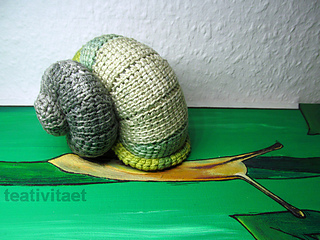


















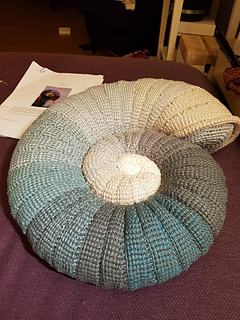
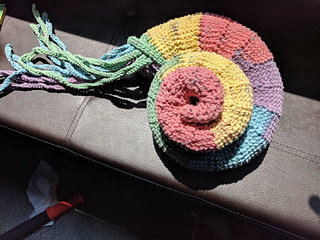




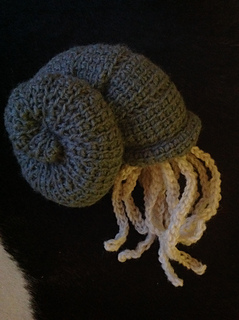




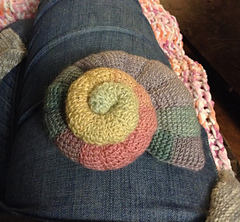










Ammonit
English:
Ammonites are fossilized sea creatures. They are formed like ram’s horns, named after the Egyptian god Amon whose animal was the ram. Once, ammonites roamed the seven seas, all bright and fearsome. Now, all we have are some dull colored stones. This is your opportunity to give them back their sparkle!
For the mathematically inclined: Each section is build up according to the Fibonacci sequence (1, 1, 2, 3, 5, 8, 13, 21, 34, 55, …). As the Fibonacci sequence is a model for natural growth, the ammonites look rather realistic.
There are two versions given in the pattern: For a fast-growing ammonite and for a slow-growing one. Tentacles are optional.
The ammonite is worked in Tunisian crochet, with short rows. These stitches are based on the Tunisian Simple Stitch. They are also known as linked stitches. All new terminology is explained in the pattern.
The pattern comes with picture tutorials for all stitches and techniques used.
yarn: 4ply cotton. Yarn can be substituted ad libitum.
hook: 3 mm (US size C or D) You do not need a special Tunisian hook for this pattern!
other notions: polyfill and a darning needle
Gauge is not important for this pattern. Just chose a hook that gives you a dense fabric.
Thanks to Waldmaus for proofreading and to the member of the free pattern testers group for testing!
The pattern is available in (US) English and German.
Ammoniten sind urzeitliche Versteinerungen von Weichtieren, die eine spiralige Schale hatten (benannt nach dem ägyptischen Gott Amon, dem der Widder zugeordnet war). Es gibt heute ähnliche Tiere, sie heißen Perlboot oder Nautilus und haben Schalen aus Perlmutt.
Für mathematisch Interessierte: Jeder Abschnitt basiert auf der Fibonacci-Reihe (1, 1, 2, 3, 5, 8, 13, 21, 34, 55, …). Da die Fibonacci-Reihe ein Model für natürliches Wachstum ist, sieht der Ammonit recht realistisch aus.
Die Anleitung umfaßt zwei Varianten, einen Ammonit mit schnell wachsender Schale und einen mit langsam wachsender Schale. Tentakel sind optional.
Der Ammonit wird mit verkürzten Reihen von einfachen tunesischen Maschen gehäkelt, die auch verbundene Stäbchen genannt werden. Alle Maschen und Techniken werden bebildert erklärt.
Garn: vierfädige Baumwolle. Das Garn kann beliebig ersetzt werden.
Häkelnadel: 3 mm. Es muss keine spezielle tunesische Häkelnadel sein.
anderes: Füllwatte und eine Stopfnadel
Eine Maschenprobe ist nicht nötig. Das Gehäkelt sollte nur dicht sein, damit es ausgestopft werden kann.
Vielen Dank an Waldmaus fürs Korrekturlesen und an alle, die frühere Versionen der Anleitung testgehäkelt haben!
Die Anleitung ist auf deutsch und auf englisch erhältlich.
Eine frühe Version der Anleitung war im Häkelclub der Handarbeitsfrauen, für einen CAL im November 2009. Die aktuelle Version ist vom Juli 2013.
10975 projects
stashed
4550 times
- First published: November 2009
- Page created: November 16, 2009
- Last updated: January 13, 2025 …
- visits in the last 24 hours
- visitors right now





